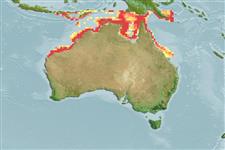Elasmobranchii (haaien en roggen) (sharks and rays) >
Orectolobiformes (Carpet sharks) >
Hemiscylliidae (Bamboo sharks)
Etymology: Hemiscyllium: hemi-, from hemisys (Gr.), half, presumably referring to similarity and/ or close affinity to Scyllium (=Scyliorhinus, now in Scyliorhinidae) and/or Chiloscyllium; skylion, Greek for dogfish or small shark (See ETYFish); trispeculare: tri-, from tres (L.), three; specularis (L.), watchful or looking, referring to three eyespots (ocelli) on shoulder (See ETYFish).
More on author: Richardson.
Environment: milieu / climate zone / depth range / distribution range
Ecologie
marien rifbewoner; diepte 0 - 50 m (Ref. 54542). Tropical; 8°S - 22°S, 114°E - 152°E (Ref. 54542)
Western Pacific: northern Australia (including Western Australia) (Ref. 6871). Possibly in the Mollucas (Indonesia).
Lengte bij maturiteit / Grootte / Gewicht / Leeftijd
Maturity: Lm ?, range 53 - ? cm
Max length : 79.0 cm TL mannelijk / geslacht onbekend; (Ref. 43278)
Dorsale stekels (totaal) : 0; Anale stekels: 0. Body covered with numerous, densely clustered dark, small and large spots that form a reticular network of light ground color between them; dark crossbands strong on ventral surface of tail (Ref. 13575).
Found on shallow coral reefs of the continental shelf (Ref. 247). Probably mainly feeding on benthic invertebrates (Ref. 6871). Oviparous (Ref. 50449).
Levenscyclus en paargedrag
Maturiteit | Voortplanting | Paaien | Eieren | Fecunditeit | Larven
Oviparous, paired eggs are laid. Embryos feed solely on yolk (Ref. 50449).
Compagno, L.J.V., 1984. FAO Species Catalogue. Vol. 4. Sharks of the world. An annotated and illustrated catalogue of shark species known to date. Part 1 - Hexanchiformes to Lamniformes. FAO Fish. Synop. 125(4/1):1-249. Rome, FAO. (Ref. 247)
Status op de Rode Lijst van het IUCN (Ref. 130435: Version 2024-1)
Gebruik door de mens
Visserij: van minder commercieel belang
Tools
Can't connect to MySQL database fbquizv2. Errorcode: Too many connections
